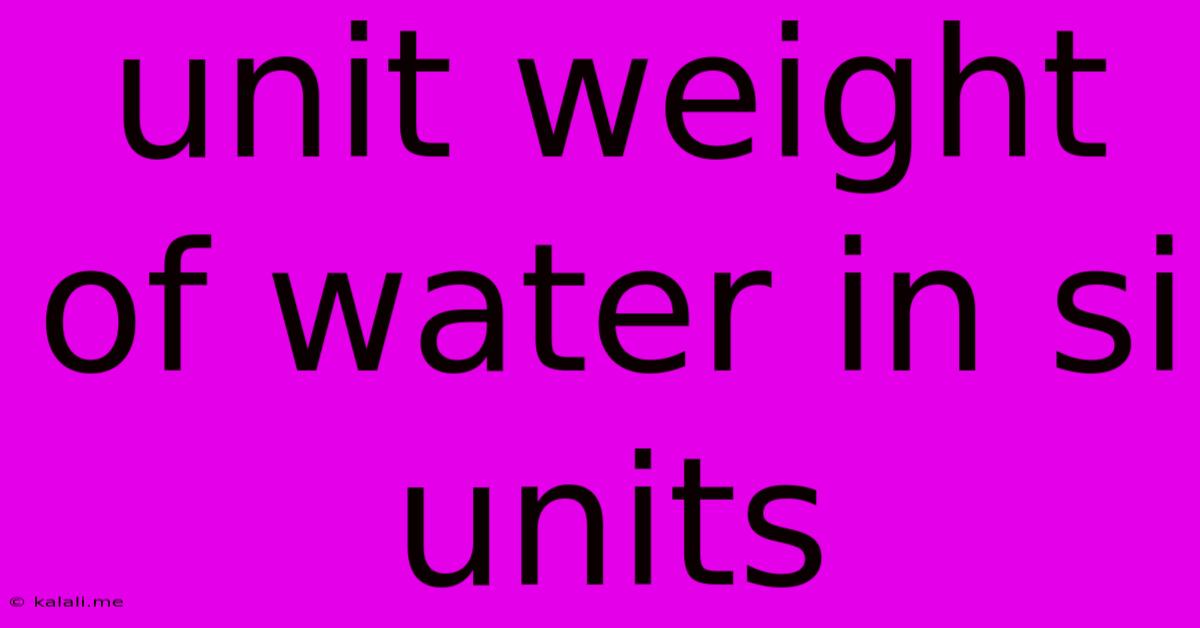Unit Weight Of Water In Si Units
Kalali
Jun 15, 2025 · 3 min read

Table of Contents
Unit Weight of Water in SI Units: A Comprehensive Guide
The unit weight of water, also known as the specific weight of water, is a crucial value in many engineering and scientific calculations. Understanding its value and its implications is essential for accurate results in fields like hydrology, hydraulics, and civil engineering. This article will delve into the unit weight of water, explaining its definition, its value in SI units, and factors that might influence it.
What is Unit Weight?
Unit weight, or specific weight, represents the weight per unit volume of a substance. It's different from density, which measures mass per unit volume. Unit weight incorporates the effect of gravity, making it a measure of force per unit volume. The formula for unit weight (γ) is:
γ = ρg
where:
- γ = unit weight (N/m³)
- ρ = density (kg/m³)
- g = acceleration due to gravity (m/s²)
Unit Weight of Water in SI Units
The standard value for the density of water (ρ) at 4°C (39.2°F) and standard atmospheric pressure is approximately 1000 kg/m³. The standard acceleration due to gravity (g) is approximately 9.81 m/s². Therefore, the unit weight of water (γ) is calculated as:
γ = (1000 kg/m³)(9.81 m/s²) = 9810 N/m³
This means that one cubic meter of water weighs approximately 9810 Newtons under standard conditions. This is often rounded to 9800 N/m³ for simpler calculations. It's crucial to remember that this is an approximation, and the actual value might vary slightly based on several factors.
Factors Affecting the Unit Weight of Water
Several factors can influence the unit weight of water, leading to deviations from the standard value of 9810 N/m³:
- Temperature: Water density changes with temperature. It's maximum at 4°C and decreases as the temperature increases or decreases. This directly affects the unit weight.
- Pressure: Increased pressure leads to a slight increase in water density and hence unit weight. This effect is usually negligible for most engineering applications.
- Salinity: Saltwater has a higher density than freshwater due to the dissolved salts. This results in a higher unit weight. The unit weight of seawater typically ranges from 10000 to 10300 N/m³, depending on salinity.
- Altitude: The acceleration due to gravity (g) decreases with altitude. Consequently, the unit weight of water at higher altitudes will be slightly lower.
Applications of Unit Weight of Water
Knowing the unit weight of water is critical in various applications:
- Hydraulic calculations: Determining pressure in pipelines, reservoirs, and dams.
- Hydrostatic force calculations: Calculating the force exerted by water on submerged structures.
- Buoyancy calculations: Determining the buoyant force acting on submerged or floating objects.
- Soil mechanics: Estimating the seepage forces in soil.
- Irrigation and drainage design: Calculating water flow rates and pressures in irrigation systems.
Conclusion:
The unit weight of water in SI units is approximately 9810 N/m³ under standard conditions. This value is crucial in numerous engineering and scientific disciplines. However, it's essential to consider factors like temperature, pressure, salinity, and altitude that might affect the actual unit weight in specific applications. Accurate calculations require careful consideration of these influencing variables and using the appropriate value for the specific situation. Remember to always reference appropriate tables and data for precise values based on the specific conditions of your application.
Latest Posts
Latest Posts
-
The Milky Way Is Classified As A
Jun 15, 2025
-
G Is The Centroid Of Triangle Abc
Jun 15, 2025
-
How Many Molecules Are In One Mole
Jun 15, 2025
-
A Bomb Calorimeter Is Used To Measure
Jun 15, 2025
-
Is 43 A Prime Or Composite Number
Jun 15, 2025
Related Post
Thank you for visiting our website which covers about Unit Weight Of Water In Si Units . We hope the information provided has been useful to you. Feel free to contact us if you have any questions or need further assistance. See you next time and don't miss to bookmark.